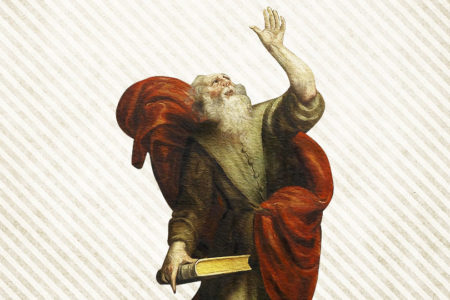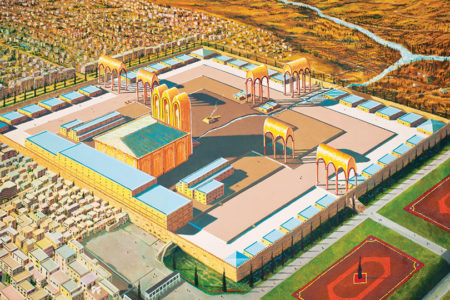The Talmud
“No! No! No!” the grandmother screamed as the six-year-old boy placed the clean spoon into the drawer of clean utensils. “That spoon goes with the milchig [dairy].” The youngster should have known; it was one of the rules he had learned early in life. But remembering that dairy products and everything they touch must remain separate from meat and everything associated with it (including clean dishes and utensils) was not always easy, despite his grandmother’s startling reminder. That event from 35 years ago is still etched in my memory. I was that boy. Our family’s eating habits were governed by the rabbinical interpretation of the biblical law, “Thou shalt not boil a kid in his mother’s milk” (Ex. 23:19).
The lifestyle of millions of Jewish families has been formed, shaped, and developed over the years by rabbinical interpretation, commentary, regulation, and homilies of the Jewish Scripture. After hundreds of years of memorizing the increasing wisdom and knowledge of what was called the Oral Law, the great Jewish academies of Jerusalem and Babylon forged an incredible compilation and systematic work that would serve as a kind of encyclopedia of rabbinical commentary. It is called the Talmud.
As the basic text and primary source for Jewish law, the Talmud, which means teaching, studying, or process of learning, covers almost every conceivable area of human interest. Actually there are two Talmuds. One is called the Palestinian or Jerusalem Talmud (Yerushalmi), after its place of origin, and the other is called Babylonian (Babli), also after its place of origin, Babylon. Contributors to the Palestinian Talmud, which was completed in AD 350, lived in such Israeli cities as Tiberias, Safad, and Caesarea. The Babylonian Talmud, containing well over 2 million words, is about three times the size of the Palestinian Talmud. Its contributors lived in such Babylonian cities as Sura, Nahardea, and Pumbeditha. It was finished in AD 500. Of the two, it is regarded as the more authoritative.
The Talmud is divided into two sections, the Mishnah (repeat) and Gemarah (supplements). The Mishnah is a vast, divergent commentary on the Scriptures from sages and scholars before 220 A.D. It was compiled and edited by Judah Hanasi (the Prince), the great-grandson of the famous Hillel, from the great sages called Tannaim. The Gemarah, written in Aramaic, is a “completion” of opinions, illustrations, and decisions of scholars called Amoraim. Simply stated, it is a commentary on the commentary.
The Mishnah is divided into six orders, each order having a number of tractates, or sections (63 in all). The orders are as follows: Zeraim (seeds)—11 tractates, all relating to laws concerning agriculture, crops, and gifts for the poor; Moed (festivals)—12 tractates dealing with feasts, fast days, and Sabbath laws; Nashim (women)—seven tractates expounding on laws relating to marriage, as well as rulings on incest, divorce, and property; Nezikin (damages) 10 tractates devoted to civil and penal laws, vows, punishments, etc.; Kodeshim (holy things) 12 tractates addressing the laws of the Temple and sacrifices; and Toharot (purity) 12 tractates, stating the laws of ritual purity. The Talmud combines the two writings. Thus, you may have three or four lines of Mishnah written in Hebrew, followed by several pages of Gemorah written in Aramaic.
The Talmud contains two distinct types of material: Halacha, meaning “to follow,” which covers the laws and observances of the Jewish people; and Aggadah, meaning “narration,” which covers personal, social, national, and international relationships.
Once the Talmud was completed, it became apparent that scholars were having trouble understanding what was written. Although it was arranged into subject matter, the contents of the Talmud are not arranged logically, and the material becomes very technical. In addition, there are numerous abbreviations, foreign words, and difficult idioms. In light of this situation, many rabbis and scholars over the years have devoted themselves to providing “helps,” such as dictionaries and lexicons, guidelines, and codes to help in the understanding of the Talmud. Eventually some of these “helps” found themselves within the pages of the Talmud for easy reference.
Over the years, the study of the Talmud has been limited. The early copies were all hand-written and were thus difficult to secure, even to copy. The first known printed copy was completed in Guadalajara, Spain, in 1482. Remnants of that work still survive.
Another difficulty was the prohibition to study the Talmud from so-called “Christians” (not born-again believers as we know them). The “church” was having difficulty with the trend of rationalistic thinking. Part of the method of suppressing independent thinking of its members was to foster a “clergy only” interpretation. The Talmud posed a real threat to that philosophy because of the various rabbis commenting on Scripture. Several popes ordered the confiscation and burning of Talmuds in Rome, France, and Poland.
Today, access to the Talmud is as easy as a walk through the bookstore at the local mall or even the Internet. Most Jewish people around the world have the freedom to study it, but only a small percentage take advantage of that freedom.
It cannot be emphasized enough that, while rabbinical insight can be helpful, the view that the Talmud is equal to Scripture is false. If only my grandmother had understood that, she might not have been so upset over the misplaced silverware!







